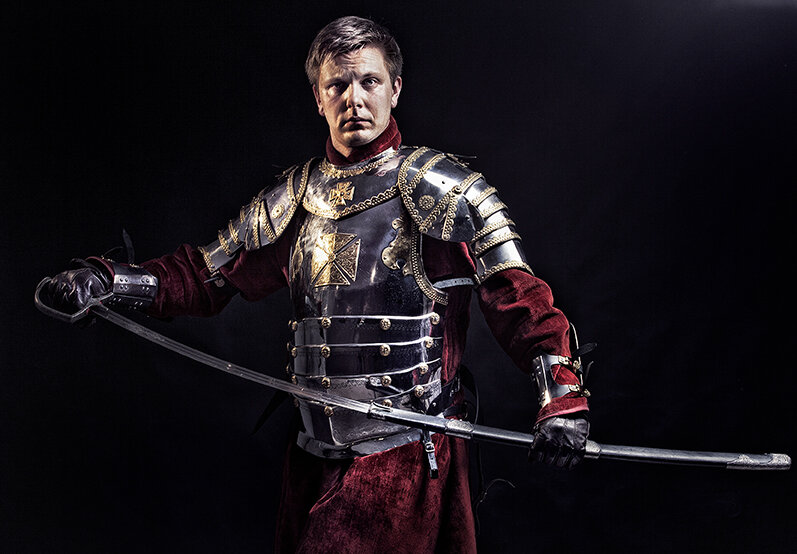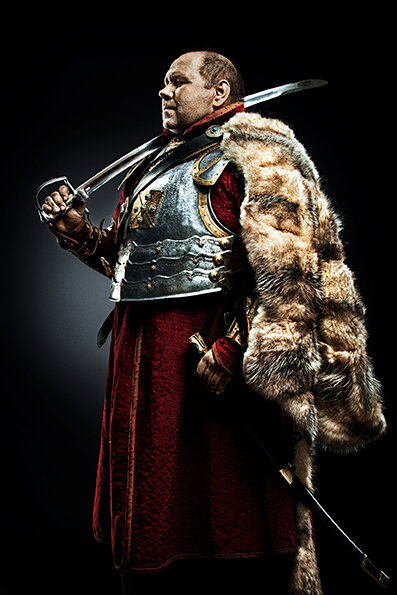On the Necessity of Hussar Armor
“A chicken in every pot, and a battle-harness in every home.” Words to ponder, words to live by. So what do I mean? Well, no half measures, dilution or counterfeits. An articulated set of gleaming steel, with a breastplate, backplate, oriental style bracers, a lobster-tail helmet and a gorget to protect the neck. (The neck always needs protection, it’s one of those things you learn quickly when people are trying to kill you). You need one, I need one, we all need one and, should it assist, I can point you in the direction of some armourers who will furnish you with appropriate wares. You should anticipate a wait of about a year as the parts emerge rough from the forge and slowly take on a complete shape. And yes, it is advisable to have a spare set, to deal with those occasions when your best suit is out being polished and you have some guests to entertain or perhaps a would-be-burglar to terrify. I suspect that when someone goes out to burgle a house, they are really looking for light and marketable luxury goods to sell on or fence. They were probably not expecting you in six feet of burnished steel as part of the bargain. Well, surprise!
Hussar, Andrzej Wiktor
Of course, in this world of frenetic intemperance, we will have the scoffers. This does not apply to you, of course, reader. I could detect your impeccable culture immediately. But they will say—pointless! Exorbitant! Childish! A fantasy! And—pointless! (This will not prevent them from asking for pictures, however, so that they can display them in whichever medium garners the most attention). Nevertheless, a decent respect for the opinions of mankind requires a justification for certain actions, and I can defend this one on the grounds of the beautiful, the good, and the true. Those are indeed worthy defences, which I intend to rely on, the basis of art and surest ground of an artist. But you want more, don’t you? So you’ll get more. The very nature of the thing, those three fundamentals working their way out in particular cuts and edges. So, in three words: arrest, invincibility, and hiddenness.
Beauty, especially extreme beauty, has on occasion elements of violence and paralysis. It strikes you as a blow, the shudder you have in a car as it stops suddenly, throwing you against the safety belt. And yes, the word stunning has been overused and it now appears as a description of everything from apartments to Tinder profiles. But this armour is stunning, is arresting, drawing in the light and your attention, demanding both. Which is what you would expect. When hussar knights appeared on the battlefield, this quality was supposed to intimidate—the usual stuff—riders, pale horses, and all Hell breaking loose.
Lancer - The success of a hussar charge was based on their hollow lance, the kopia. Up to 20 feet long, it proved its worth in countless engagements.
There is also the distinct experience of wearing the armour. Normally, a strike to your chest would hurt. With a stick, you might take some bruises, perhaps crack a rib. With a sword or a hammer, it’s game over. In armour, though, you feel the impact but are utterly unharmed. The shape of the breastplate encourages blows to skitter off to the left or right. Perhaps you recall the old Norse myths about the god Balder, where everything in the universe apart from mistletoe swore not to harm him? Then the other gods played a game where they threw weapons and rocks and him—and found him invulnerable. This made them happy. It is one thing to read about it, another to feel confidence and euphoria, adult and child within you gloriously radiant. You are not just impassable. You have become impassibility, and nothing can hurt you.
And finally, hiddenness. In Terry Pratchett’s Hogfather, the character of Death has a conversation with his granddaughter. (Don’t ask.) Here’s how it goes, with Death speaking first:
“Yes. Justice. Mercy. Duty. That sort of thing.”
“They’re not the same at all!”
“You think so? Then take the universe and grind it down to the finest powder and sieve it through the finest sieve and then show me one atom of justice, one molecule of mercy.”
“And yet”—Death waved a hand.
Captain, Andrzej Wiktor - The characteristic half plate armour of the hussars is shown on a regimental officer here. He wears a delia coat and carries a horsemen’s hammer as a mark of office.
“And yet you act as if there is some ideal order in the world, as if there is some . . . some rightness in the universe by which it may be judged.”
Death always gets the last word, and here he’s right again. There isn’t a single atom of courage in the universe, not an ounce of nobility. There isn’t any measure of bravery, and as for identity, you can’t, for instance, show yourself being Polish or American or French in any other way than making it physically manifest. Art is a type of sacramental. It is the means by which the conversation of the living and the dead is prolonged. It is a proof for who we are and what we value. We have to become the winged horsemen, the angel knights, to show the angels inside us.
And here, dearest reader, you should imagine me smiling, and it is a real smile, with humour, but also hard, a grin which shows the edge of teeth, and because certain things are both funny and true—there is something wild in my eyes, something untameable, which speaks of the pride of a tribe that was long ago and far away, of the very deepest woods and campfires in the Old Country, of dark forests and tangled, where, if you pause and listen, you can still hear the griffins calling to each other and, ever so faintly, the wings of eagles.
The Winged Horsemen
Andrzej Wiktor
This series depicts a particular type of cavalry unit unique to Poland: the hussars. The hussars were active in the sixteenth and seventeenth centuries and were characterized by their singular appearance and fortitude. They were largely undefeated during their period of operation, often taking on opponents when outnumbered three to one or more. Their most famous engagement was the relief of the siege of Vienna in 1683.
The photographs depict contemporary Poles dressed in historical reproductions of hussar armor. The participants are associated with an re-enactment society based in the castle of Gniew (g-nyeah-fff) in North Poland.
Andrzej Wiktor and Gabriel Olearnik are personal friends. When Gabriel saw Andrzej’s series of “Knighthood” pictures a few years ago, he suggested that they work on something in the future. A few months ago, they met and agreed to produce a revised series of photographs to accompany Gabriel’s new essay.
















